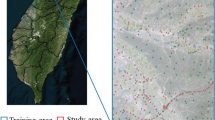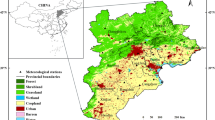Abstract
Understanding the impact of climate change on vegetation and its evolution trend requires long-term accurate data on regional vegetation types and their geographical distribution. Currently, land use and land cover types are mainly obtained based on remote sensing information. Little research has been conducted on remote sensing interpretation of vegetation types and their geographical distributions in terms of the comprehensive utilization of remote sensing, climate, and terrain. A new region vegetation mapping method based on terrain-climate-remote sensing was developed in this study, supported by the Google Earth Engine (GEE) and the random forest algorithm, which is a new generation of earth science data and analysis application platform, together with optimal vegetation mapping features obtained from the average impure reduction method and out-of-bag error value, using different information from remote sensing, climate, and terrain. This vegetation of Qinghai-Xizang Plateau with 10 m spatial resolution in 2020 was mapped, in terms of this new vegetation mapping method, Sentinel-2A/B remotely sensed images, climate, and terrain. The accuracy verification of vegetation mapping on the Qinghai-Xizang Plateau showed an overall accuracy of 89.5% and a Kappa coefficient of 0.87. The results suggest that the regional vegetation mapping method based on terrain-climate-remote sensing proposed in this study can provide technical support for obtaining long-term accurate data on vegetation types and their geographical distributions on the Qinghai-Xizang Plateau and the globe.
Similar content being viewed by others
References
Bartholomé E, Belward A S. 2005. GLC2000: A new approach to global land cover mapping from Earth observation data. Int J Remote Sens, 26: 1959–1977
Breiman L. 2001. Random forests. Machine Learn, 45: 5–32
Chen J, Chen J, Liao A, Cao X, Chen L, Chen X, He C, Han G, Peng S, Lu M, Zhang W, Tong X, Mills J. 2015. Global land cover mapping at 30m resolution: A POK-based operational approach. ISPRS J Photogrammetry Remote Sens, 103: 7–27
Editorial Board of the Vegetation Map of China, Chinese Academy of Sciences. 2007a. Vegetation Map of the People’s Republic of China (1:1000000). Beijing: Geology Publishing House
Editorial Board of the Vegetation Map of China, Chinese Academy of Sciences. 2007b. Vegetation and its Geographical Pattern in China-description of Vegetation Map of the People’s Republic of China (1:1000000). Beijing: Geology Publishing House
Farr T G, Rosen P A, Caro E, Crippen R, Duren R, Hensley S, Kobrick M, Paller M, Rodriguez E, Roth L, Seal D, Shaffer S, Shimada J, Umland J, Werner M, Oskin M, Burbank D, Alsdorf D. 2007. The shuttle radar topography mission. Rev Geophys, 45: RG2004
Feng M, Li X. 2020. Land cover mapping toward finer scales. Sci Bull, 65: 1604–1606
Friedl M A, Sulla-Menashe D, Tan B, Schneider A, Ramankutty N, Sibley A, Huang X. 2010. MODIS collection 5 global land cover: Algorithm refinements and characterization of new datasets. Remote Sens Environ, 114: 168–182
Gong P, Liu H, Zhang M, Li C, Wang J, Huang H, Clinton N, Ji L, Li W, Bai Y, Chen B, Xu B, Zhu Z, Yuan C, Ping Suen H, Guo J, Xu N, Li W, Zhao Y, Yang J, Yu C, Wang X, Fu H, Yu L, Dronova I, Hui F, Cheng X, Shi X, Xiao F, Liu Q, Song L. 2019. Stable classification with limited sample: Transferring a 30-m resolution sample set collected in 2015 to mapping 10-m resolution global land cover in 2017. Sci Bull, 64: 370–373
Gong P, Wang J, Yu L, Zhao Y, Zhao Y, Liang L, Niu Z, Huang X, Fu H, Liu S, Li C, Li X, Fu W, Liu C, Xu Y, Wang X, Cheng Q, Hu L, Yao W, Zhang H, Zhu P, Zhao Z, Zhang H, Zheng Y, Ji L, Zhang Y, Chen H, Yan A, Guo J, Yu L, Wang L, Liu X, Shi T, Zhu M, Chen Y, Yang G, Tang P, Xu B, Giri C, Clinton N, Zhu Z, Chen J, Chen J. 2013. Finer resolution observation and monitoring of global land cover: First mapping results with Landsat TM and ETM+ data. Int J Remote Sens, 34: 2607–2654
Gorelick N, Hancher M, Dixon M, Ilyushchenko S, Thau D, Moore R. 2017. Google Earth Engine: Planetary-scale geospatial analysis for everyone. Remote Sens Environ, 202: 18–27
Hansen M C, Defries R S, Townshend J R G, Sohlberg R. 2000. Global land cover classification at 1 km spatial resolution using a classification tree approach. Int J Remote Sens, 21: 1331–1364
He Y, Huang C, Li H, Liu Q, Liu G, Zhou Z, Zhang C. 2019. Land-cover classification of random forest based on Sentinel-2A image feature optimization (in Chinese). Resour Sci, 41: 992–1001
Liu H, Gong P, Wang J, Wang X, Ning G, Xu B. 2021. Production of global daily seamless data cubes and quantification of global land cover change from 1985 to 2020—iMap World 1.0. Remote Sens Environ, 258: 112364
Liu J, Liu M, Tian H, Zhuang D, Zhang Z, Zhang W, Tang X, Deng X. 2005. Spatial and temporal patterns of China’s cropland during 1990–2000: An analysis based on Landsat TM data. Remote Sens Environ, 98: 442–456
Pu D, Wang G, Zhang Z, Niu X, He G, Long T, Yin R, Jiang W, Sun J. 2020. Urban area extraction based on independent component analysis and random forest algorithm (in Chinese). J Geo-Inform Sci, 22: 1597–1606
Su Y, Guo Q, Hu T, Guan H, Jin S, An S, Chen X, Guo K, Hao Z, Hu Y, Huang Y, Jiang M, Li J, Li Z, Li X, Li X, Liang C, Liu R, Liu Q, Ni H, Peng S, Shen Z, Tang Z, Tian X, Wang X, Wang R, Xie Z, Xie Y, Xu X, Yang X, Yang Y, Yu L, Yue M, Zhang F, Ma K. 2020. An updated vegetation map of China (1:1000000). Sci Bull, 65: 1125–1136
Sulla-Menashe D, Gray J M, Abercrombie S P, Friedl M A. 2019. Hierarchical mapping of annual global land Cover 2001 to present: The MODIS Collection 6 Land Cover product. Remote Sens Environ, 222: 183–194
Wang L, Kong Y, Yang X, Xu Y, Liang L, Wang S. 2020. Classification of land use in farming areas based on feature optimization random forest algorithm (in Chinese). Trans CSAE, 36: 244–250
Xu X, Li B, Liu X, Li X, Shi Q. 2021. Mapping annual global land cover changes at a 30 m resolution from 2000 to 2015. Natl Remote Sens Bull, 25: 1896–1916
Xu X, Liu J, Zhang S, Li R, Yan C, Wu S. 2018. China’s Multiperiod Land Use Land Cover Remote Sensing Monitoring Data Set (CNLUCC). Beijing: Resource of Environment Data Cloud Platform
Zhang X, Liu L, Chen X, Xie S, Gao Y. 2019. Fine land-cover mapping in China using Landsat datacube and an operational SPECLib-Based approach. Remote Sens, 11: 1056
Zhang Y, Li B, Liu L, Zheng D. 2021. Redetermine the region and boundaries of Tibetan Plateau. Geogr Res, 40: 1543–1553
Zhang Z, Wang X, Zhao X, Liu B, Yi L, Zuo L, Wen Q, Liu F, Xu J, Hu S. 2014. A 2010 update of National Land Use/Cover Database of China at 1:100000 scale using medium spatial resolution satellite images. Remote Sens Environ, 149: 142–154
Acknowledgements
The vegetation map of Qinghai-Xizang Plateau in 2020 with 10 m spatial resolution can be found online at https://doi.org/10.11888/Terre.tpdc.272408. This work was supported by the Second Tibetan Plateau Scientific Expedition and Research Program (Grant No. 2019QZKK0106).
Author information
Authors and Affiliations
Corresponding author
Electronic supplementary material
Rights and permissions
About this article
Cite this article
Zhou, G., Ren, H., Liu, T. et al. A new regional vegetation mapping method based on terrain-climate-remote sensing and its application on the Qinghai-Xizang Plateau. Sci. China Earth Sci. 66, 237–246 (2023). https://doi.org/10.1007/s11430-022-1006-1
Received:
Revised:
Accepted:
Published:
Issue Date:
DOI: https://doi.org/10.1007/s11430-022-1006-1




